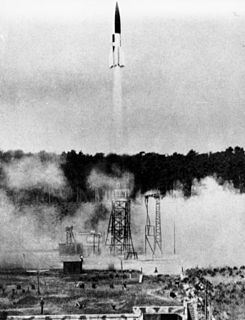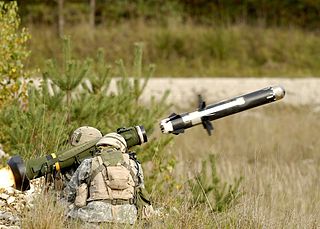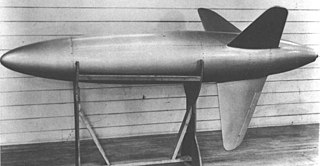Description
The AA.20 was command guided, using a similar system to that used by Nord's anti-tank missiles, [2] with the missile being steered visually from the launching aircraft. Angled, fixed wings imparted a steady roll rate, while a gyroscope provided information on the orientation of the missile to the control mechanism. At launch, a twin solid rocket booster fired to bring the missile up to speed, after which a single solid-fueled sustainer rocket maintained speed following burnout of the booster. Four interrupter blades, placed around the sustainer motor's nozzle, provided steering, while a flare mounted on the rear of the missile aided in visual tracking for guidance. [1]
The AA.20's warhead was a 23-kilogram (51 lb) blast-fragmentation type, detonated by a proximity fuze set to trigger the warhead at a distance of 15 metres (49 ft) from the target. [1] The range of the 134-kilogram (295 lb) missile was approximately 4 kilometres (2.5 mi). The command guidance of the AA.20 allowed for it to be used in a secondary role as an air-to-surface missile, [3] although it also meant that the missile could not be used at night or in bad weather. [2]
The overall shape of the missile was to be later used on a series of air-to-ground missiles (AS-20 then AS-30, which evolved into the AS-30L laser-guided variant (the first French laser-guided air-to-ground weapon).

In military terminology, a missile is a guided airborne ranged weapon capable of self-propelled flight usually by a jet engine or rocket motor. Missiles are thus also called guided missiles or guided rockets. Missiles have five system components: targeting, guidance system, flight system, engine and warhead. Missiles come in types adapted for different purposes: surface-to-surface and air-to-surface missiles, surface-to-air missiles, air-to-air missiles, and anti-satellite weapons.

An anti-tank guided missile (ATGM), anti-tank missile, anti-tank guided weapon (ATGW) or anti-armor guided weapon is a guided missile primarily designed to hit and destroy heavily armored military vehicles. ATGMs range in size from shoulder-launched weapons, which can be transported by a single soldier, to larger tripod-mounted weapons, which require a squad or team to transport and fire, to vehicle and aircraft mounted missile systems.

The AGM-114 Hellfire is an air-to-surface missile (ASM) first developed for anti-armor use, but later models were developed for precision drone strikes against other target types, and have been used in a number of actions aimed to "destroy high-value targets." It was originally developed under the name Heliborne laser, fire-and-forget missile, which led to the colloquial name "Hellfire" ultimately becoming the missile's formal name. It has multi-mission, multi-target precision-strike ability, and can be launched from multiple air, sea, and ground platforms, including the Predator drone. The Hellfire missile is the primary 100-pound (45 kg) class air-to-ground precision weapon for the armed forces of the United States and many other nations. It has also been fielded on surface platforms in the surface-to-surface and surface-to-air roles.

An air-to-air missile (AAM) is a missile fired from an aircraft for the purpose of destroying another aircraft. AAMs are typically powered by one or more rocket motors, usually solid fueled but sometimes liquid fueled. Ramjet engines, as used on the Meteor, are emerging as propulsion that will enable future medium-range missiles to maintain higher average speed across their engagement envelope.

The Convair RIM-2 Terrier was a two-stage medium-range naval surface-to-air missile (SAM), and was among the earliest surface-to-air missiles to equip United States Navy ships. It underwent significant upgrades while in service, starting with beam-riding guidance with a 10-nautical-mile (19 km) range at a speed of Mach 1.8, and ending as a semi-active radar homing system with a range of 40 nmi (74 km) at speeds as high as Mach 3. It was replaced in service by the RIM-67 Standard ER (SM-1ER).

Seaslug was a first-generation surface-to-air missile designed by Armstrong Whitworth for use by the Royal Navy. Tracing its history as far back as 1943's LOPGAP design, it came into operational service in 1961 and was still in use at the time of the Falklands War in 1982.

The HOT is a second-generation long-range anti-tank missile system. It was originally developed to meet a joint German-French Army requirement to replace the older SS.11 wire guided missile. The design was a collaboration between the German firm Bölkow and the French firm Nord. Bölkow and Nord later merged into MBB and Aérospatiale respectively, both of which then formed Euromissile to design and produce the MILAN, Roland and HOT. This ultimately became part of MBDA.

SS.11 is the designation of the Nord Aviation MCLOS wire-guided anti-tank missile. In American service, the missile was designated the AGM-22. The missile entered service with the French Army in 1956. Production of the SS.11/SS.12 series ceased some time in the 1980s, by which time over 170,000 had been sold. The price of the SS.11 in the late 1960s was stated at approximately $1,900 U.S. dollars.
The SS.12 and AS.12 are two variants of the same missile: SS for surface-to-surface and AS for air-to-surface. It was designed in 1955-1957 by Nord Aviation, later Aérospatiale. It was a derivative of the NORD SS-10 and SS-11 missiles which were surface-to-surface wire-guided missiles for use by infantry, vehicle or a helicopter primarily in the anti-tank role, but also anti-material, anti-personnel and against light field fortifications. The SS.12/AS.12 was basically a scaled-up version of the SS.11/AS.11, with a massive increase in range and warhead weight. The SS.12/AS.12 original mission was primarily to be anti-shipping from naval helicopters and combat aircraft or ground launchers, and secondarily for use against heavy field fortifications. The range and the destructive power of its warhead are roughly equivalent to a 127 mm (5-inch) artillery shell.

The 9M123 Khrizantema is a Russian anti-tank guided missile. Khrizantema was designed to deal with current and future generations of main battle tanks and can also be used to engage slow and low flying aerial targets like helicopters. The 9M123 missile together with its associated guidance system forms the 9K123 missile system.

The Gorgon missile family was a series of experimental air-to-air, air-to-surface, and surface-to-surface missiles developed by the United States Navy's Naval Aircraft Modification Unit between 1943 and 1953. The immaturity of the technology involved meant that none of the Gorgon missiles achieved operational service, however they were extensively used in the development of guided missile controls and guidance technologies.

The AS-30 was an air-to-ground missile built by Nord Aviation. It was a precision attack weapon designed to be used against high-value targets such as bridges and bunkers. The AS-30 was essentially a larger version of the earlier AS-20 design, and initially used that weapon's guidance system, which required pilots to track the weapon visually and correct its path using a small joystick, while also flying their own aircraft. All such MCLOS systems proved very difficult to use in practice. The updated AS-30L replaced this system with a semi-active laser homing system, which allows the missile to fly to the target without operator intervention. About 60 AS-30Ls were launched during Operation Desert Storm and Operation Deliberate Force with great success.
The AS-25K is an Argentine air-to-surface missile (ASM) under development by the CITEFA in two versions: air-to-sea and air-to-land. The main user is the COAN of the Argentine Navy.

The JB-4, also known as MX-607, was an early American air-to-surface missile developed by the United States Army Air Forces during World War II. Using television/radio-command guidance, the JB-4 reached the flight-testing stage before being cancelled at the end of the war.

Sea Killer is an Italian anti-ship missile family. The latest development of the system is known as Marte. Marte is a sea skimming, subsonic, anti-ship missile, it carries a 70 kilograms (150 lb) semi-armour piercing warhead. It has been built in several versions, with differing guidance systems, and is suitable for launching from ships or aircraft.

The AAM-N-5 Meteor was an early American air-to-air missile, developed by the Massachusetts Institute of Technology and Bell Aircraft for the United States Navy. Initially, both air-launched and ship-launched versions were considered. Versions designed for launch from carrier-based aircraft proceeded to the flight testing stage before the project was cancelled.

The CTV-N-2 Gorgon IIC – also designated KGN, KUN, and CTV-2 – was an experimental drone, originally intended as a surface-to-surface missile, developed by the United States Navy near the end of World War II. It was used to test control and homing systems for guided missiles, and was also produced in small numbers as a target drone under the designations TD3N and KD2N.

The Republic SD-3 Snooper was an early reconnaissance drone developed by Republic Aviation for the United States Army. It was evaluated by the Army Signal Corps in 1959, but did not enter operational service.

The Fairchild SD-5 Osprey was an early high-speed reconnaissance drone developed by Fairchild Aircraft for the United States Army. Intended for use by the U.S. Army Signal Corps to target tactical ballistic missiles, it was cancelled before the first prototype could be completed, and did not see operational service.

The JB-3 Tiamat, also designated MX-570, was an early air-to-air missile developed by Hughes Aircraft for the United States Army Air Forces during World War II. Regarded as a purely experimental vehicle, test launches took place for several years before the program was terminated.


















